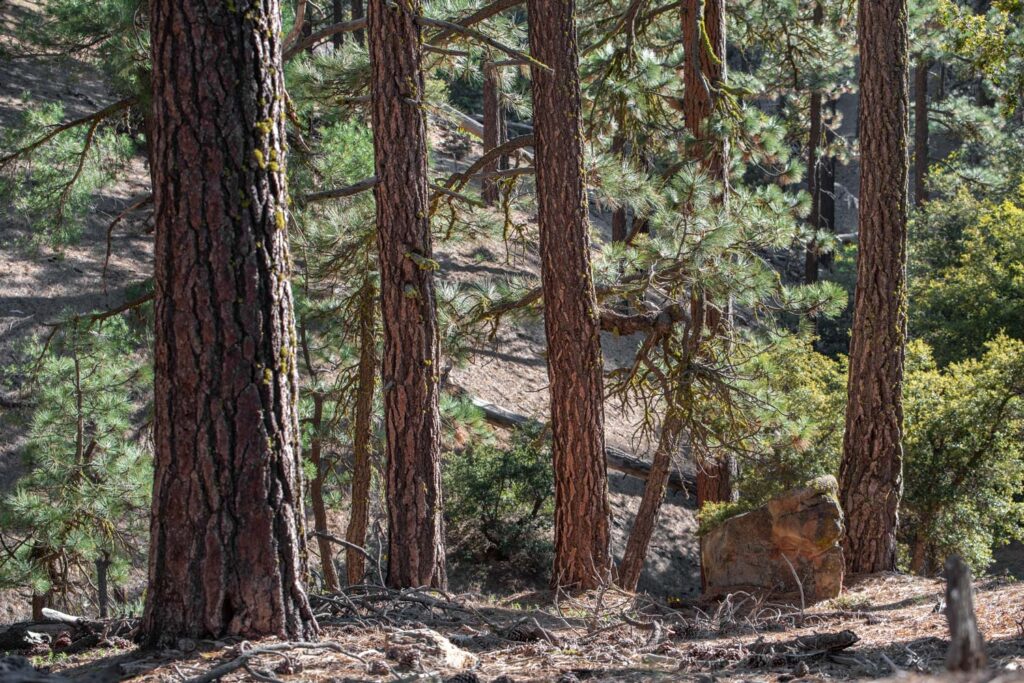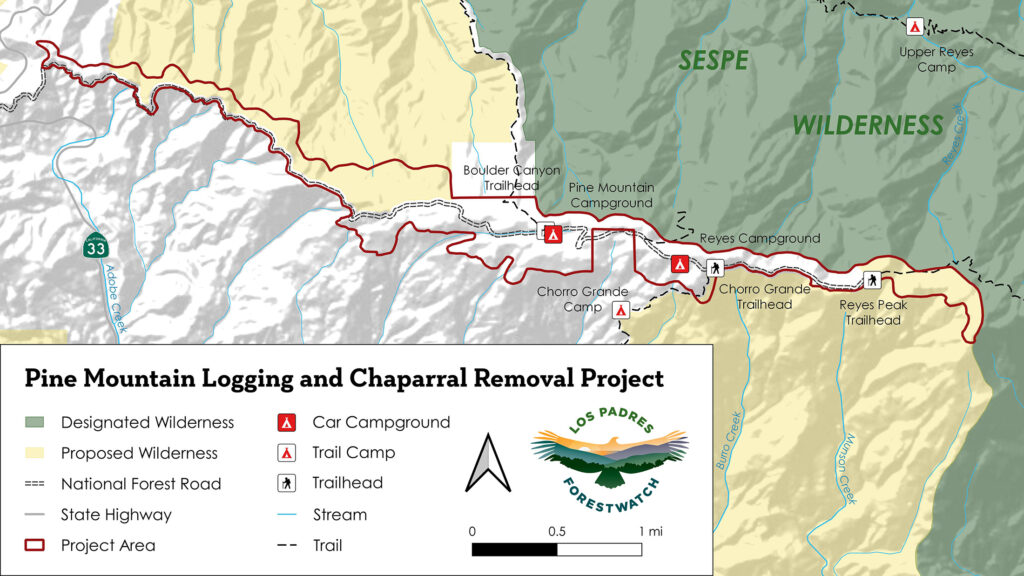
Ventura County, Calif.—Wednesday, a federal judge declined to halt a controversial logging and vegetation clearing project atop Pine Mountain and Reyes Peak in the Los Padres National Forest. The ruling comes nearly two years after the project was approved despite the opposition of Indigenous groups, conservation organizations, scientists, businesses, local governments, and members of the general public who submitted a collective 16,000 comments to the Forest Service.
In 2022, a coalition of conservation organizations, the County of Ventura, and the City of Ojai filed lawsuits against the Forest Service on the grounds that the logging and chaparral clearing project would violate environmental laws, harm vulnerable wildlife, and do irreparable damage to intact roadless areas of the forest.
The judge’s ruling would allow the Forest Service to use heavy equipment to cut and potentially sell native trees and grind shrubs across 755 acres on the top of Pine Mountain.
“We believe this ruling is incorrect and are working with our legal team to determine next steps,” said Jeff Kuyper, Executive Director of Los Padres ForestWatch. “We will explore all of our options for protecting Pine Mountain from a misguided and potentially damaging project.”
The project area—equivalent in size to 575 American football fields—is located on ancestral lands of the Chumash. It is historically and culturally important to Indigenous people, popular with locals and tourists for a range of recreational activities, designated critical habitat for the endangered California condor, and home to other sensitive wildlife, rare plants, old-growth conifer forests, and unique ecosystems.
The Forest Service received more comments on this proposal than any other project in the history of the Los Padres. Over 99% of the comments opposed the project. Indigenous groups, ecologists at UCSB, archaeologists, retired U.S. Fish and Wildlife scientists, dozens of conservation organizations, and thousands of people in Ventura County and the surrounding region weighed in during the single public comment period in 2020, requesting that major changes be made to the project and/or that the agency prepare a more robust environmental assessment or environmental impact statement before moving forward. Most commenters were concerned about the use of heavy equipment to cut trees up to and larger than two feet in diameter as well as grind native shrubs into mulch. These requests and concerns were dismissed by the Forest Service, which did not make any changes to the project when approving it in 2021.
“Logging on Pine Mountain and Reyes Peak would permanently disfigure a pristine natural area, harm wildlife, and deface a sacred cultural site. We’re reviewing the decision and discussing next steps to protect this beautiful and ecologically critical part of the forest,” said Maggie Hall, Senior Attorney at the Environmental Defense Center.
The lawsuits filed in the U.S. District Court for the Central District of California in Los Angeles alleged violations of the National Environmental Policy Act, Roadless Area Conservation Rule, Endangered Species Act, National Forest Management Act, and took aim at the Forest Service’s failure to collaborate with stakeholders. Such collaboration is required whenever the Forest Service relies on a categorical exclusion under the National Environmental Policy Act to expedite a project.
“We had hoped the court would rule in favor of the planet, biodiversity and the community,” said Hans Cole, head of Environmental Activism at Patagonia. “We’re disappointed, but the work to protect Pine Mountain will continue. Pine Mountain is 90 minutes from our headquarters in Ventura and the area is important to our employees and customers because of its outdoor recreation opportunities, including rock climbing, hiking and camping. We’ll keep advocating for more conservation of Los Padres National Forest, including the provisions proposed in the Central Coast Heritage Protection Act, and we’ll keep urging the federal government to protect mature and old-growth trees.”

The plaintiffs claimed that the Forest Service violated the 2001 Roadless Area Conservation Rule’s prohibition on the removal of larger trees. The suit also alleged violations of the Endangered Species Act for allowing the removal of an unlimited number of large trees in which endangered California condors roost, providing places to rest during long flights across the landscape. The project would also harm rare California spotted owls, northern goshawks, rare plants, and two species of bats whose populations are declining.
The plaintiffs also alleged that the project violates the National Forest Management Act because the agency failed to comply with the Los Padres National Forest Plan standards that protect scenic integrity and the natural character of the area. Clearing thousands of trees and hundreds of acres of chaparral on Pine Mountain, an area prized for its natural beauty and abundant outdoor recreation opportunities, is a drastic elimination of native vegetation with effects that will linger for generations and is not allowed under the 2005 Forest Plan for the Los Padres National Forest.
Plaintiffs are Los Padres ForestWatch, Keep Sespe Wild Committee, Earth Island Institute, and American Alpine Club, collectively represented by the Environmental Defense Center; and the Center for Biological Diversity, California Chaparral Institute, and Patagonia Works, represented by the Center for Biological Diversity.








Comments are closed.